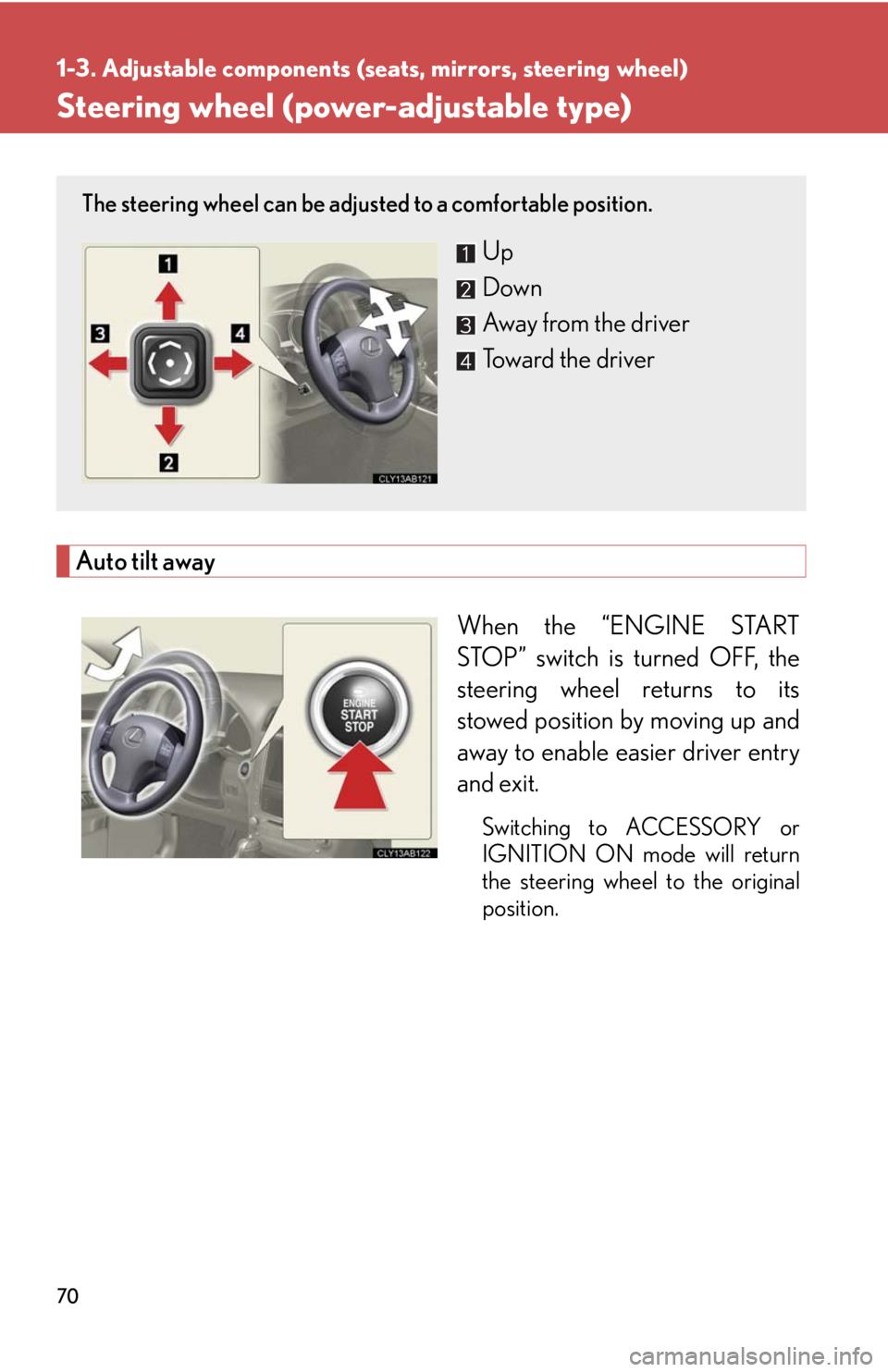power steering Lexus IS250 2010 Using The Air Conditioning System And Defogger / LEXUS 2010 IS350 IS250 OWNERS MANUAL (OM53A23U)
[x] Cancel search | Manufacturer: LEXUS, Model Year: 2010, Model line: IS250, Model: Lexus IS250 2010Pages: 578, PDF Size: 16.25 MB
Page 2 of 578

TABLE OF CONTENTSIndex
2
1-1. Key information
Keys ...................................................... 24
1-2. Opening, closing and locking
the doors and trunk
Smart access system with
push-button start .......................... 28
Wireless remote control .............. 40
Doors.................................................... 43
Trunk..................................................... 47
1-3. Adjustable components
(seats, mirrors,
steering wheel)
Front seats ........................................... 51
Driving position memory
(driver’s seat) ................................. 53
Seat position memory
(front passenger’s seat) ............. 57
Head restraints................................. 59
Seat belts ............................................ 62
Steering wheel (manually
adjustable type)............................. 69
Steering wheel
(power-adjustable type)............ 70
Anti-glare inside rear view
mirror ................................................ 72
Outside rear view mirrors ........... 731-4. Opening and closing the
windows and moon roof
Power windows................................ 76
Moon roof .......................................... 79
1-5. Refueling
Opening the fuel tank cap........... 83
1-6. Theft deterrent system
Engine immobilizer system ......... 86
Alarm................................................... 88
Theft prevention labels
(U.S.A.) ............................................. 90
1-7. Safety information
Correct driving posture ................ 91
SRS airbags ....................................... 93
Front passenger occupant
classification system .................. 104
Child restraint systems ............... 109
Installing child restraints ............... 113
1Before driving
Page 23 of 578

Before driving1
23
1-1. Key information
Keys ............................................... 24
1-2. Opening, closing and
locking the doors and
trunk
Smart access system with
push-button start ................... 28
Wireless remote control ........ 40
Doors ............................................ 43
Trunk ............................................. 47
1-3. Adjustable components
(seats, mirrors,
steering wheel)
Front seats .................................... 51
Driving position memory
(driver’s seat) ........................... 53
Seat position memory
(front passenger’s seat) ........ 57
Head restraints .......................... 59
Seat belts ..................................... 62
Steering wheel (manually
adjustable type) ...................... 69
Steering wheel
(power-adjustable type) ....... 70Anti-glare inside rear view
mirror......................................... 72
Outside rear view mirrors...... 73
1-4. Opening and closing the
windows and moon roof
Power windows ........................... 76
Moon roof ................................... 79
1-5. Refueling
Opening the fuel tank cap ..... 83
1-6. Theft deterrent system
Engine immobilizer
system........................................ 86
Alarm............................................ 88
Theft prevention labels
(U.S.A.)...................................... 90
1-7. Safety information
Correct driving posture .......... 91
SRS airbags ................................ 93
Front passenger occupant
classification system............ 104
Child restraint systems ......... 109
Installing child restraints........ 113
Page 52 of 578

52
1-3. Adjustable components (seats, mirrors, steering wheel)
CAUTION
■Seat adjustment
●Do not recline the seat more than necessary when the vehicle is in motion to
reduce the risk of sliding under the lap belt.
If the seat is too reclined, the lap belt may slide past the hips and apply restraint
forces directly to the abdomen or your neck may contact the shoulder belt,
increasing the risk of death or serious injury in the event of an accident.
●Manual seat only: After adjusting the seat, make sure that the seat is locked in
position.
Power seat
Seat position switch
Seatback angle switch
Seat cushion (front) angle switch
Vertical height adjustment switch
Lumbar support switch
Page 70 of 578

70
1-3. Adjustable components (seats, mirrors, steering wheel)
Steering wheel (power-adjustable type)
Auto tilt away
When the “ENGINE START
STOP” switch is turned OFF, the
steering wheel returns to its
stowed position by moving up and
away to enable easier driver entry
and exit.
Switching to ACCESSORY or
IGNITION ON mode will return
the steering wheel to the original
position.
The steering wheel can be adjusted to a comfortable position.
Up
Down
Away from the driver
Toward the driver
Page 95 of 578

95
1-7. Safety information
1
Before driving
In certain types of severe frontal or side impacts, the SRS airbag system
triggers the airbag inflators. A chemical reaction in the inflators quickly
fills the airbags with non-toxic gas to help restrain the motion of the occu-
pants.
■SRS warning light
This warning light system monitors the airbag sensor assembly, front airbag sensors,
side and curtain shield airbag sensor assemblies, curtain shield airbag sensor
assemblies, driver's seat position sensor, driver's seat belt buckle switch, seat belt
pretensioner assemblies, inflators, interconnecting wiring and power sources.
(P. 4 7 2 )
■If the SRS airbags deploy (inflate)
●Bruising and slight abrasions may result from contact with a deploying (inflating)
SRS airbag.
●A loud noise and white powder will be emitted.
●Parts of the airbag module (steering wheel, airbag cover and inflator) as well as
the front seats, and parts of the front pillar, rear pillar and roof side rail, may be
hot for several minutes. The airbag itself may also be hot.
●The windshield may crack.
●For Safety Connect subscribers, if the SRS airbags deploy or in the event of a
severe rear-end collision, the system is designed to send an emergency call to
the response center, notifying them of the vehicle’s location (without needing to
push the “SOS” button) and an agent will attempt to speak with the occupants
to ascertain the level of emergency and assistance required. If the occupants
are unable to communicate, the agent automatically treats the call as an emer-
gency and helps to dispatch the necessary emergency services. (P. 3 7 3 )
Page 128 of 578

128
2-1. Driving procedures
CAUTION
●Moving the shift lever to N while the vehicle is moving will disengage the engine
from the transmission. Engine braking is not available when N is selected.
●During normal driving, do not turn off the engine. Turning the engine off while
driving will not cause loss of steering or braking control, but the power assist to
these systems will be lost. This will make it more difficult to steer and brake, so you
should pull over and stop the vehicle as soon as it is safe to do so.
However, in the event of an emergency, such as if it becomes impossible to stop
the vehicle in the normal way: P. 4 7 1
●Use engine braking (downshift) to maintain a safe speed when driving down a
steep hill.
Using the brakes continuously may cause the brakes to overheat and lose effec-
tiveness. (P. 1 4 0 )
●When stopped on an inclined surface, use the brake pedal and parking brake to
prevent the vehicle from rolling backward or forward and causing an accident.
●Do not adjust the position of the steering wheel, the seat, or the inside or outside
rear view mirrors while driving.
Doing so may result in a loss of vehicle control that can cause accidents that may
result in death or serious injury.
●Always check that all passengers' arms, heads or other parts of their bodies are
not outside the vehicle, as this may result in death or serious injury.
●Do not drive the vehicle off-road.
This is not a AWD vehicle designed for real off-road driving. Proceed with all due
caution if it becomes unavoidable to drive off-road.
●Do not drive across river crossings or through other bodies of water.
This may cause electric/electronic components to short circuit, damage the
engine or cause other serious damage to the vehicle.
●Do not drive in excess of the speed limit. Even if the legal speed limit permits it, do
not drive over 85 mph (140 km/h) unless your vehicle has high-speed capability
tires. Driving over 85 mph (140 km/h) may result in tire failure, loss of control and
possible injury. Be sure to consult a tire dealer to determine whether the tires on
your vehicle are high-speed capability tires or not before driving at such speeds.
Page 132 of 578

132
2-1. Driving procedures
NOTICE
■When driving the vehicle
●Do not depress the accelerator and brake pedals at the same time during driving,
as this may restrain the engine output.
With automatic transmission vehicles
●Do not use the accelerator pedal or depress the accelerator and brake pedals
together to hold the vehicle on a hill.
With manual transmission vehicles
●Do not rest your foot on the clutch pedal while driving.
Doing so may cause clutch trouble.
●Do not use any gear other than the first gear when starting off and moving for-
ward.
Doing so may damage the clutch.
●Do not use the clutch to hold the vehicle when stopping on an uphill grade.
Doing so may damage the clutch.
■When parking the vehicle
With automatic transmission vehicles, always put the shift lever in P. Failure to do so
may cause the vehicle to move or the vehicle may accelerate suddenly if the accel-
erator pedal is accidentally depressed.
■Avoiding damage to vehicle parts
●Do not turn the steering wheel fully in either direction and hold it there for a long
time.
Doing so may damage the power steering motor.
●When driving over bumps in the road, drive as slowly as possible to avoid damag-
ing the wheels, underside of the vehicle, etc.
Page 133 of 578

133
2-1. Driving procedures
2
When driving
NOTICE
■If you hear a squealing or scraping noise (brake pad wear limit indicators)
Have your Lexus dealer check and replace the brake pads as soon as possible.
Rotor damage can result if the pads are not replaced when needed.
Front brake only: Moderate levels of brake pad and disc wear allow enhanced front
braking power. As a result, the discs may wear more quickly than conventional
brake discs. Therefore, when replacing the brake pads, Lexus recommends that you
also have the thickness of the discs measured.
It is dangerous to drive the vehicle when the wear limits of the brake pads and/or
those of the brake discs are exceeded.
■If you get a flat tire while driving
A flat or damaged tire may cause the following situations. Hold the steering wheel
firmly and gradually press the brake pedal to slow down the vehicle.
●It may be difficult to control your vehicle.
●The vehicle will make abnormal sounds.
●The vehicle will behave abnormally.
Replace a flat tire with a new one. (P. 4 9 4 )
■When encountering flooded roads
Do not drive on a road that has flooded after heavy rain etc. Doing so may cause the
following serious damage to the vehicle.
●Engine stalling
●Short in electrical components
●Engine damage caused by water immersion
In the event that you drive on a flooded road and the vehicle is flooded, be sure to
have your Lexus dealer check the following.
●Brake function
●Changes in quantity and quality of oil and fluid used for the engine, transmission,
transfer (AWD vehicles), differential, etc.
●Lubricant condition for the propeller shaft (AWD vehicles), bearings and suspen-
sion joints (where possible) and the function of all joints, bearings, etc.
Page 137 of 578

137
2-1. Driving procedures
2
When driving
■If the engine does not start
The engine immobilizer system may not have been deactivated. (P. 8 6 )
■When the steering lock cannot be released
■When the “ENGINE START STOP” switch indicator flashes in amber
The system may be malfunctioning. Have the vehicle inspected by your Lexus
dealer immediately.
■Auto power off function
If the vehicle is left in ACCESSORY mode for more than an hour with the shift lever
in P (vehicles with an automatic transmission), the “ENGINE START STOP” switch
will automatically turn OFF.
■Electronic key battery depletion
P. 3 4
■When the electronic key battery is fully discharged
P. 4 3 4
■Conditions affecting operation
P. 3 2
■Note for the entry function
P. 3 5
The “ENGINE START STOP” switch indica-
tor will flash in green and a message will be
shown on the multi-information display. Press
the “ENGINE START STOP” switch again
while turning the steering wheel left and right.
Page 138 of 578

138
2-1. Driving procedures
CAUTION
■When starting the engine
Always start the engine while sitting in the driver’s seat. Do not press the accelera-
tor while starting the engine under any circumstances.
Doing so may cause an accident resulting in death or serious injury.
■Stopping the engine in an emergency
If you want to stop the engine in an emergency while driving the vehicle, push and
hold the “ENGINE START STOP” switch for more than 3 seconds.
However, do not touch the "ENGINE START STOP" switch while driving except in
an emergency. Turning the engine off while driving will not cause loss of steering or
braking control, but the power assist to these systems will be lost. This will make it
more difficult to steer and brake, so you should pull over and stop the vehicle as
soon as it is safe to do so.
NOTICE
■To prevent battery discharge
Do not leave the “ENGINE START STOP” switch in ACCESSORY or IGNITION
ON mode for long periods without the engine running.
■When starting the engine
●Do not race a cold engine.
●If the engine becomes difficult to start or stalls frequently, have the engine
checked immediately.